Studio visit: François Jacob
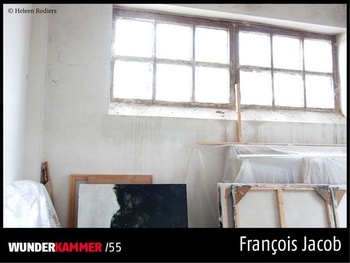
Once upon a time... It might be the ideal opener for the multifarious and ambiguous narratives with which painter François Jacob (1976) builds his pictorial universe, never flinching from the treacherous hackles the grotesque and warm figures that populate his fables occasionally raise. It’s a world where love and conflict rub shoulders, where lightness cherishes weight as a condition of possibility, where the deep gloss of his enamel paint counters earthly dullness, where consequences shroud causes in mystery, where the laws of nature are defied, and a fish proves itself more potent out of water than in. Paintings as stories, stories as generous and freely outspreading possibilities of worlds. “I am addicted to storytelling, the figurative: I want my work to represent something. That gives me the greatest joy. And that is what I attempt to achieve in everything I do: attain that joy and the skill of conveying something.” In the midst of a society that overwhelmingly produces images, he increasingly develops the story. “Nowadays, collecting images is easy, there are so many of them. Increasingly, my work is evolving in the direction of composition: away from mere conclusions, away from the pictorial punch in favour of the story. The tension developed between a before and an after. Something has happened or something will happen. Because that is what storytelling is: a before and an after. And that development is becoming richer all the time.”
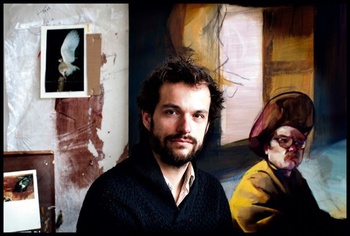
Although, narrative desire was already present in François Jacob’s earlier work. “Yes, that is very clear if you look at Fôret, for example, a black and white painting I made two and a half years ago. The drawing functions as the basis for the painting, also on a technical level. I consider paintings as a journey. You can’t grasp everything all at once, you have to go from one point to the next. I also make paintings the subjects of which have more affinity with drawings: you think of something and throw it onto the canvas. Technically, Forêt is closer to a drawing, but to me its subject and generosity are much closer to what a painting should be.”
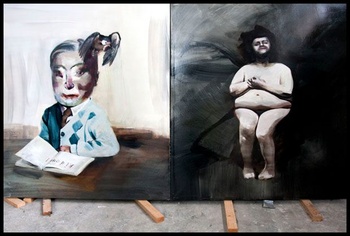
He has never been able, or even willing, to shake off that personal history. François Jacob is grounded in the tradition of draughtsmanship – illustration – and still alternates painting with drawing. One of the cupboards in his studio contains framed drawings from the period that he didn’t paint. “They are each on one subject, very simple, with the occasional short text. I even used to draw cartoons.” Another little pile of drawings is ready for the exhibition that will soon open in the Kapel van Boondaal/Chapelle de Boondael. They are delectable, skilfully drawn black and white images that ally greyness to exuberant laughter. They sometimes look surprisingly soft, even intimate. As though he manages to unite the two irreconcilable worlds of caricature and subtlety. “Yes, I think I can agree with that. I like caricature, but not the grimaces. I like the grotesque, the things that make you laugh but are also sad or unsettling and a bit dark. That combination of the exuberant and the subtle is the fine line I try to walk.”

Ambiguity, friction, and paradox are all recurring aspects of his work. “Exactly. You have to be able to slip from one kind of interpretation into another. Or at least, I do try to create that kind of openness. I start from the pictorial side, from an image that resonates, something that attracts me in its form, something I can use to break things open by taking them out of their context – like those fish out of water. I don’t always know exactly what it is, but I can always spontaneously imagine myself painting it. And then I start composing without thinking about it too much. It is always rather intuitive.” There is just as much ambiguity in his vision. “I take equal enjoyment from alternating the large compositions with something ridiculous, something idiotic, something very simple. I want to steer a course somewhere between all those borders. Mud, shit, and smoke – those indeterminable forms also attract me. Such as in Volute, for example, a drawing of something like magma, something beautiful that comes out of a rear-end. [Laughs] Or the madonnas I often draw and paint. That excess weight fascinates me: to me, it symbolises generosity, free forms, abundance, the absence of structure. And that is all preferable to leanness!”
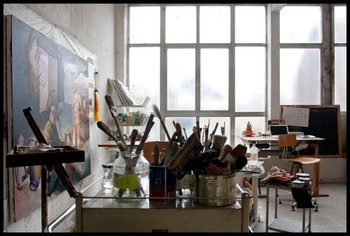
La Pisseuse, his first sculpture, also testifies to that spontaneous thematic caprice. “I learned to do that at a foundry in Hainaut/Henegouwen where I was allowed to cast artistic sculptures in bronze. I learned to make moulds, and worked with wax, silicone, plaster, and bronze. But I take things easy because it’s such an enormous world. It is a completely different language and I am used to working with images, not volumes. I like this one, though, because it’s consonant with my other work. Furthermore, it is ideal to take some distance from painting. Drawing, making moulds, sculpting, or making frames for my paintings – that variety does me good. I find manual labour relaxing. And it saves me some money.” [Laughs]
The diversity of his work does not hinder the creation of a harmonious universe. “Yes, it is not planned, and sometimes it even eludes me, but I do hope that it shows. If you’re sincere and don’t try to do everything at once – which is sometimes a problem for me [Laughs] – I think it is possible to build a universe. And then that becomes clear from the fact that the same themes recur. I sometimes think I am broaching a subject for the first time: ‘What a good idea!’ And then I realise that I’ve done it before. Indirectly and slight differently, those things constantly recur.”
To paint is to look for balance. “Painting is a battle, it is looking for the right balance, for blends, for the alliance between lightness and heaviness. It’s a job with no end, a metaphor for life: the time, the project, the purpose, the technique. It is to organise but also to leave room for little accidents or mistakes. If a painting doesn’t have any issues or problems, it ceases to live. And it needs to breathe.”
The diversity of his work does not hinder the creation of a harmonious universe. “Yes, it is not planned, and sometimes it even eludes me, but I do hope that it shows. If you’re sincere and don’t try to do everything at once – which is sometimes a problem for me [Laughs] – I think it is possible to build a universe. And then that becomes clear from the fact that the same themes recur. I sometimes think I am broaching a subject for the first time: ‘What a good idea!’ And then I realise that I’ve done it before. Indirectly and slight differently, those things constantly recur.”
To paint is to look for balance. “Painting is a battle, it is looking for the right balance, for blends, for the alliance between lightness and heaviness. It’s a job with no end, a metaphor for life: the time, the project, the purpose, the technique. It is to organise but also to leave room for little accidents or mistakes. If a painting doesn’t have any issues or problems, it ceases to live. And it needs to breathe.”
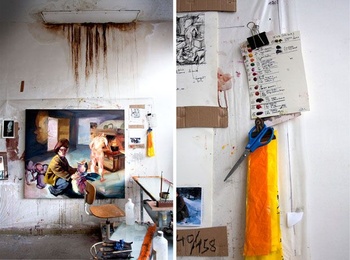
One of the ways François Jacob breathes life into his work is by alternating humour and seriousness. “I definitely need that variety. It provides a bit of rest. After my studies I stopped painting for a while. Three years ago, I started again with great passion and enthusiasm. And I’ve noticed that my work is becoming increasingly serious, that I too have changed. My older work is much more playful and does not evince the same concerns. These days, I treat life less from day to day than I used to. There is less time to lose. I can’t imagine doing anything else with my life. So I have no choice: it’s this or nothing.”

François Jacob has a beautiful studio at his disposal for his life’s work. “The place isn’t perfect, but on the other hand, the rent is very reasonable. Walking in here always makes me smile. Fortunately, the exhibition is only running for one week: I will be there every day, and I think I would die if I was away from this place for any longer.” Two large spaces with plenty of light provide space for his materials, moulds, paintings, drawings, computer, worktables, and cupboards. As well as his very own mood board. “I’m always storing images away, which sometimes resurface years later. I don’t necessarily use them all. What I do use is either lying around en vrac between all the mess, or is organised in files thematically – interiors, artists I like, naked women, faces, people, etc.” His colour palette, which he has meticulously painted on a strip of paper, is equally well-organised. “It is very practical. In the past, if I used up a particular colour, it was gone. You lose precision: there are various shades of red, and they react differently... Since I did this, my work is more meticulous. I know exactly how to make a particular colour. But don’t be fooled by all this organisation. In some ways I’m a total maniac, but in others I’m very bordélique. Then I think: ‘Why don’t I clean that up?’ But well, le bordel, ça se fait vite.” [Laughs]
BOROUGH: Anderlecht
EXHIBITION: “Fuites”: 20 > 27/4, Kapel van Boondaal/Chapelle de Boondael, Oude Lindesquare 10 square du Vieux Tilleul, Elsene/Ixelles
INFO: www.francoisjacob.be
Photos © Heleen Rodiers
BOROUGH: Anderlecht
EXHIBITION: “Fuites”: 20 > 27/4, Kapel van Boondaal/Chapelle de Boondael, Oude Lindesquare 10 square du Vieux Tilleul, Elsene/Ixelles
INFO: www.francoisjacob.be
Photos © Heleen Rodiers
Read more about: Expo
Fijn dat je wil reageren. Wie reageert, gaat akkoord met onze huisregels. Hoe reageren via Disqus? Een woordje uitleg.